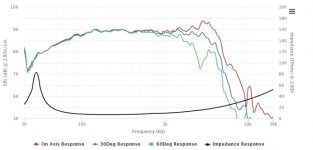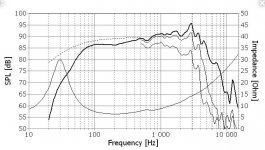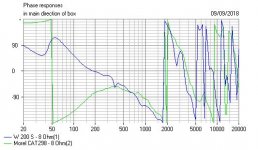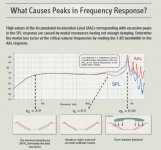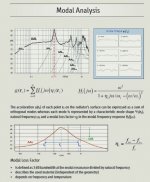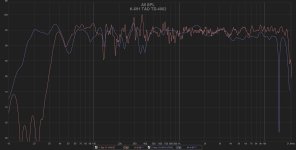Let's say there is a 3dB peak in the FR curve caused by cone break-up. Of course, building a notch filter cutting 3dB doesn't fix the cone break-up, it is a lot worse. The FR curve didn't seem very good at predicting how bad cone break-up sounds.
Distortion measurements looked pretty low, when it sounded very grainy and coarse.
The waterfall is pretty bad, but does not look like the worse thing in the world either.
So what kind of measurements would relate to the severity of cone break-up? There must be some measurement related to every auditory phenomenon, right?
Distortion measurements looked pretty low, when it sounded very grainy and coarse.
The waterfall is pretty bad, but does not look like the worse thing in the world either.
So what kind of measurements would relate to the severity of cone break-up? There must be some measurement related to every auditory phenomenon, right?
no, sorry to be the one to break it to you but there's a lot of audio phenomenon that have no measurement system or usable "metric".
a) why is the notch making matters worse?
b) And how are you going to be sure it is the 3 db break up you claim to hear? I find that premise a rather bold claim, to be honest. The metric is there, in both the time and frequency domain.
How, and if that translates to anything with audible negative effects is a whole different story. Blind testing might shed some light on these issues. Sighted Bias is audio's real worst enemy.
But how about doing a real test. Take a driver that is absolutely flat at, say 2 kHz. Then you start introducing narrow bandwith, high Q peaks from 1,0, 1.5, 2.0 2,5 dB und upwards at 2 kHz, incrementally increasing the peak, until a majority of your test audience is able to recognize difference. First start with a simple test signal, and then with music samples.
Good luck ,
Eelco
b) And how are you going to be sure it is the 3 db break up you claim to hear? I find that premise a rather bold claim, to be honest. The metric is there, in both the time and frequency domain.
How, and if that translates to anything with audible negative effects is a whole different story. Blind testing might shed some light on these issues. Sighted Bias is audio's real worst enemy.
But how about doing a real test. Take a driver that is absolutely flat at, say 2 kHz. Then you start introducing narrow bandwith, high Q peaks from 1,0, 1.5, 2.0 2,5 dB und upwards at 2 kHz, incrementally increasing the peak, until a majority of your test audience is able to recognize difference. First start with a simple test signal, and then with music samples.
Good luck ,
Eelco
There are some very definite measurements that show cone breakup AND surround issues. All drivers have them.
Breakup occurs at about 3kHz in 8" woofers. It's when the edge starts moving oppositely to the centre. In 6", it's around 5kHz. 5" around 7kHz and so on. A question of the speed of sound to the edge essentially.
This is revealed in the frequency response with a sharp turn. By mathematical definition, the phase response and group delay, being the 1st and 2nd differential coefficients of acoustic frequency response also show it.
A S-shaped zigzag in phase is stored energy. You really don't want to be listening to it, but it is less offensive in more damped drivers. Metal cones are the worst offenders, of course. I have a notion that the subsequent distortion occurs an octave higher, the second harmonic, so a 6kHz notch on an 8" bass does something good.
TBH, all very experimental. The Peerless 830869 looks quite reasonable and easy for a 3kHz crossover. As does the SEAS CA22RNX. The breakup point is 6dB down, and that distortion is 12dB down with the added contribution of the tweeter, if you think about it. And most of the problems disappear off-axis. It is interesting to me that both drivers look much more like the higher inductance SEAS CA22RNY 30 degrees off-axis.
Joachim Gerhard and Troels Gravesen both like low mechanical loss, ie high Qms. This might come with more breakup, needing more crossover work, but is a more revealing and dynamic speaker. Well, there is something in it. The overly well-behaved and inefficient driver can tend to dullness. IMO.
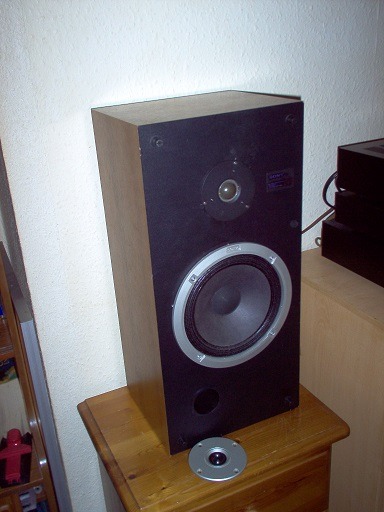
I LIKE this disreputable cheap retro Sony 8" woofer. Small magnet, no damping rings, cloth surround. 1" voicecoil and cloth dustcap. It has dynamics and detail, far better than more expensive drivers. 😕
Breakup occurs at about 3kHz in 8" woofers. It's when the edge starts moving oppositely to the centre. In 6", it's around 5kHz. 5" around 7kHz and so on. A question of the speed of sound to the edge essentially.
This is revealed in the frequency response with a sharp turn. By mathematical definition, the phase response and group delay, being the 1st and 2nd differential coefficients of acoustic frequency response also show it.
A S-shaped zigzag in phase is stored energy. You really don't want to be listening to it, but it is less offensive in more damped drivers. Metal cones are the worst offenders, of course. I have a notion that the subsequent distortion occurs an octave higher, the second harmonic, so a 6kHz notch on an 8" bass does something good.
TBH, all very experimental. The Peerless 830869 looks quite reasonable and easy for a 3kHz crossover. As does the SEAS CA22RNX. The breakup point is 6dB down, and that distortion is 12dB down with the added contribution of the tweeter, if you think about it. And most of the problems disappear off-axis. It is interesting to me that both drivers look much more like the higher inductance SEAS CA22RNY 30 degrees off-axis.
Joachim Gerhard and Troels Gravesen both like low mechanical loss, ie high Qms. This might come with more breakup, needing more crossover work, but is a more revealing and dynamic speaker. Well, there is something in it. The overly well-behaved and inefficient driver can tend to dullness. IMO.
I LIKE this disreputable cheap retro Sony 8" woofer. Small magnet, no damping rings, cloth surround. 1" voicecoil and cloth dustcap. It has dynamics and detail, far better than more expensive drivers. 😕
Attachments
There are generally two problems that cone breakup introduces that cannot be solved by notching.
The first is that in addition to getting an increase in amplitude at frequencies where breakup occurs, the cone also rings like a bell. This can be easily seen in a cumulative spectral decay measurement as ridges which extend from 0ms out to several ms. By applying a notch filter, the frequency response becomes flat at t=0ms, but the cone still rings just like it did before. I.e. ridges are still visible in the CSD, they have just been reduced by some dB due to the notch filter. Metal cone drivers have more severe ridges than say paper cone drivers, but the ridges occur higher in frequency so they are easier to avoid by choosing an appropriate crossover frequency.
The second issue is that the non-linear distortion products (harmonic, intermodulation) of lower frequencies which land on the cone breakup get 'amplified' by the cone, increasing the distortion %. Applying a notch filter does not solve this one bit, since a notch filter only reduces the fundamental and harmonics of the notch frequency (Fnotch*2, Fn*3, etc), not harmonics of lower frequencies which land at the notch/breakup frequency and are excited by the cone.
Consider this driver, the Dayton RS180:
Freq Response:
http://www.zaphaudio.com/6.5test/RS180-FR.gif
Cumulative Spectral Decay:
http://www.zaphaudio.com/6.5test/RS180-CSD.gif
Harmonic Distortion:
http://www.zaphaudio.com/6.5test/RS180-HD.gif
Note the ridges in the CSD at 6.5 and 7.5kHz due to the cone breakup/ringing. Also note the increase in 3rd harmonic ('F3') from 2-4kHz and 5th harmonic ('F5') from 1.5-2kHz - this directly corresponds to the region of breakup with 3rd order HD becoming a problem at 1/3rd the frequency of the breakup and 5th order at 1/5th the frequency.
The solution is to avoid exciting the cone at all at the problematic frequencies either directly by the fundamental or by non-linear distortion components. This means placing the crossover significantly below the frequency where breakup occurs. To fully avoid the effects of the breakup occurring on the RS180, it should be lowpassed no higher than about 1kHz.
The first is that in addition to getting an increase in amplitude at frequencies where breakup occurs, the cone also rings like a bell. This can be easily seen in a cumulative spectral decay measurement as ridges which extend from 0ms out to several ms. By applying a notch filter, the frequency response becomes flat at t=0ms, but the cone still rings just like it did before. I.e. ridges are still visible in the CSD, they have just been reduced by some dB due to the notch filter. Metal cone drivers have more severe ridges than say paper cone drivers, but the ridges occur higher in frequency so they are easier to avoid by choosing an appropriate crossover frequency.
The second issue is that the non-linear distortion products (harmonic, intermodulation) of lower frequencies which land on the cone breakup get 'amplified' by the cone, increasing the distortion %. Applying a notch filter does not solve this one bit, since a notch filter only reduces the fundamental and harmonics of the notch frequency (Fnotch*2, Fn*3, etc), not harmonics of lower frequencies which land at the notch/breakup frequency and are excited by the cone.
Consider this driver, the Dayton RS180:
Freq Response:
http://www.zaphaudio.com/6.5test/RS180-FR.gif
Cumulative Spectral Decay:
http://www.zaphaudio.com/6.5test/RS180-CSD.gif
Harmonic Distortion:
http://www.zaphaudio.com/6.5test/RS180-HD.gif
Note the ridges in the CSD at 6.5 and 7.5kHz due to the cone breakup/ringing. Also note the increase in 3rd harmonic ('F3') from 2-4kHz and 5th harmonic ('F5') from 1.5-2kHz - this directly corresponds to the region of breakup with 3rd order HD becoming a problem at 1/3rd the frequency of the breakup and 5th order at 1/5th the frequency.
The solution is to avoid exciting the cone at all at the problematic frequencies either directly by the fundamental or by non-linear distortion components. This means placing the crossover significantly below the frequency where breakup occurs. To fully avoid the effects of the breakup occurring on the RS180, it should be lowpassed no higher than about 1kHz.
Last edited:
There is also great variance, how the resonance radiates sound off-axis. It typically happens in frequencies that are beaming say -10db at 30¤. This wide radiation added to slow decay exaggerates the detoriation of sound, ie. is heard very easily. Steep xo filtering or notch helps.
Fullrange and BMR drivers try to utilize these resonances to reach upper treble. Whizzer cone is a wildly resonating add-on by nature. The nasty behaviour can be seen with superimposed on- and off-axis measurements with no or minimal smoothing. X1-08 EXOTIC F8

Fullrange and BMR drivers try to utilize these resonances to reach upper treble. Whizzer cone is a wildly resonating add-on by nature. The nasty behaviour can be seen with superimposed on- and off-axis measurements with no or minimal smoothing. X1-08 EXOTIC F8

Last edited:
@TMM: SPL are CSD are mathematically linked and differet ways of picturing the same data. One cannot have a perfectly flat SPL curve and a bad CSD. Thd is a different matter, but to what extent this is audible is a differnt matter.
Properly digitally equalized one should be able to remove the break up peak.
Properly digitally equalized one should be able to remove the break up peak.
Breakup occurs at about 3kHz in 8" woofers. It's when the edge starts moving oppositely to the centre. In 6", it's around 5kHz. 5" around 7kHz and so on. A question of the speed of sound to the edge essentially.
Hi Steve!
Does this relate only to the speed of sound through air or also to the speed of sound within the cone material?
@TMM: SPL are CSD are mathematically linked and differet ways of picturing the same data. One cannot have a perfectly flat SPL curve and a bad CSD. Thd is a different matter, but to what extent this is audible is a differnt matter.
Properly digitally equalized one should be able to remove the break up peak.
Exactly, Zaph has shown this also, that if you take a driver and EQ the resonance of cone break-up out, the CSD follows suit and the ridge disappears.
Essentially a region of cone break-up is a region of higher efficiency as the cone is ringing in sympathy with what the motor is doing. Obviously this creates a peak in a CSD plot as there's more acoustic energy that needs to dissipate once the signal is switched off. If you notch the peak you've reduced the amount of energy going into the system, so the amount of acoustic energy coming out of it is equal to the areas without break-up.
The trouble with break-up is that it's chaotic and as the cone flexes you end up with regions that are out of phase and regions that are in phase with one another. You don't just end up with peaks, but dips too and the situation changes with the off axis angle.
So while you can perfectly EQ complex break-up out it's only going to work for one specific axis and would likely need tuning to each individual driver too.
People tend to avoid break-up like the plague. There's a good reason why people like metal cone drivers as they avoid break-up issues within their usable passband. The trouble is that they have issues like TMM showed with the RS180 and its distortion plots. Soft cone drivers tend not to display issues in their distortion plots, they do not come with that caveat, but most come with some break-up issues much lower down in frequency than their main break-up. This usually creates a dip around 1Khz in 5-6" drivers. It's something people choose to live with so they don't have to deal with the issues that metal cone drivers present with.
The only logical reason why you'd pick a soft cone driver over a hard cone is if you actually need to cross over higher than a hard cone would realistically allow. Or if you needed sensitivity, which hard cones typically don't excel at due to their increased mass.
IME cone break up is a major contributor to the characteristic sound of a driver. When a cone breaks up it essentially rings and produces a sonic fingerprint that lets you know what its made of.
As can be seen in post #6 cone break up occurs fairly early. At 500 hz an 8" driver is showing signs of it. Every driver has a sweet spot between fs and break up. There is no way to avoid cone break up with a normal speaker, even a three way will have the tweeter in break up in the upper frequencies.
Maybe some exotics like a beryllium tweeter could give you a break up free speaker. Horns also break up differently than normal drivers and I suspect this is part of the reason for their quick sound. Ribbons show very little signs of break up.
I've tried to equalize out break up in all metal drivers. You really need very accurate FR information and then there maybe off axis issues.
Bottom line is that you lose information when a cone is in break up, but some kinds are worse than others.
As can be seen in post #6 cone break up occurs fairly early. At 500 hz an 8" driver is showing signs of it. Every driver has a sweet spot between fs and break up. There is no way to avoid cone break up with a normal speaker, even a three way will have the tweeter in break up in the upper frequencies.
Maybe some exotics like a beryllium tweeter could give you a break up free speaker. Horns also break up differently than normal drivers and I suspect this is part of the reason for their quick sound. Ribbons show very little signs of break up.
I've tried to equalize out break up in all metal drivers. You really need very accurate FR information and then there maybe off axis issues.
Bottom line is that you lose information when a cone is in break up, but some kinds are worse than others.
Last edited:
@TMM: Dutch&Dutch 8c uses 8" alu cone Seas woofer crossed over at 1250Hz.
Yeah...they probably used a Physics Elimination Modulator to build those! 😀
Mike
Let's say there is a 3dB peak in the FR curve caused by cone break-up...So what kind of measurements would relate to the severity of cone break-up? There must be some measurement related to every auditory phenomenon, right?
The two impulse spectrograms below shows one driver with the effects of diaphragm breakup at about 14 kHz, and another driver (TAD TD-4002) without breakup. I believe that it's very easy to see the time domain effects of non-pistonic modes using this type of plot. I recommend using relatively close miking (about 1 metre or less) and plenty of absorption on nearby surfaces--like on the floor about a metre wide all the way to the microphone of at least 1 wavelength thickness at the suspected cone breakup frequency band and on-axis SPL of at least 90 dB at one metre:

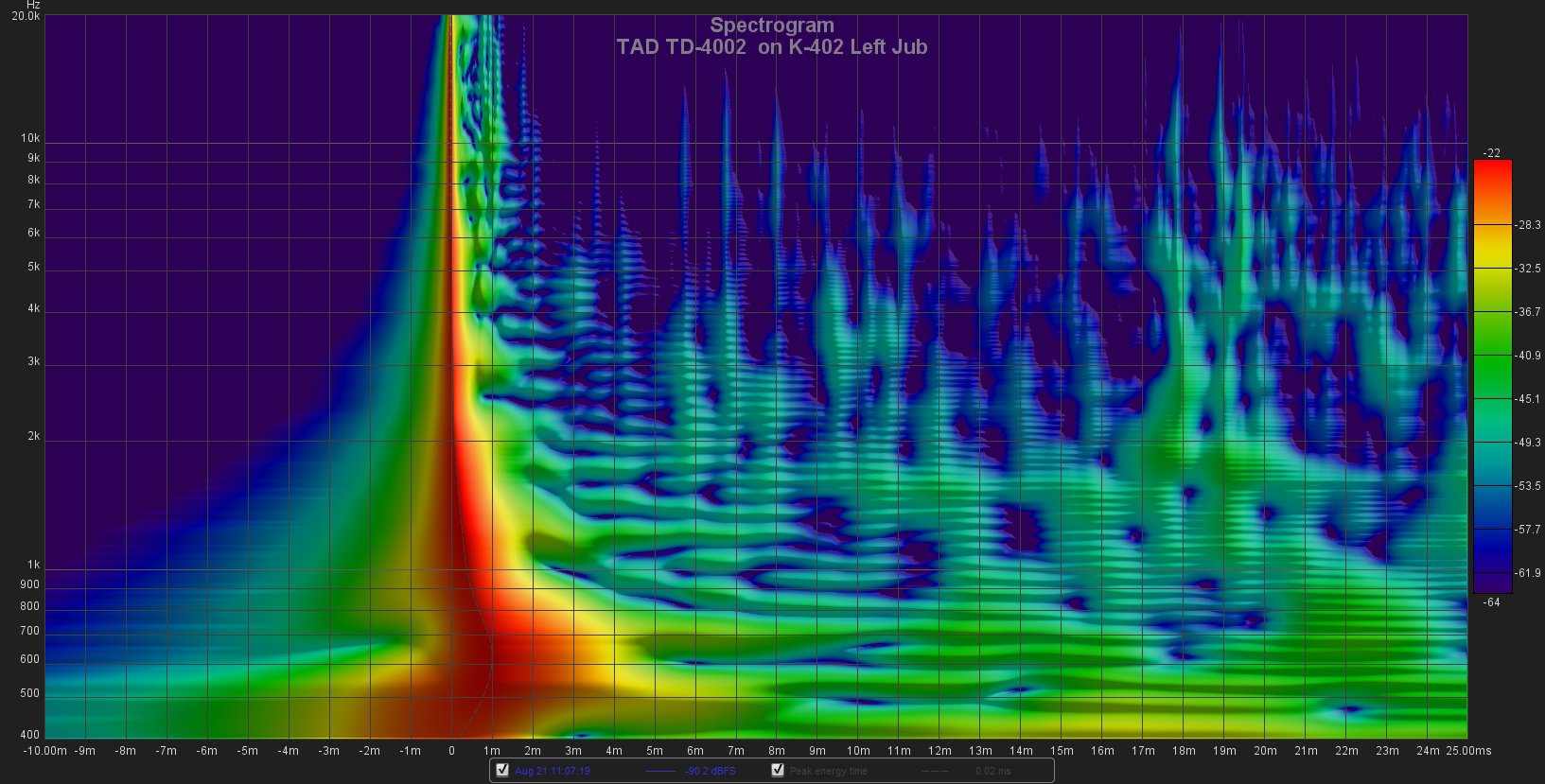
The severity of the breakup is visible and corresponds to the audibility of the problem, in my experience.
Chris
Last edited:
Here's an intermediate condition (FaitalPRO HF20AT), showing the effects of diaphragm breakup but with much less severity (visibly and audibly). Ride cymbals are very good on the FaitalPRO driver, but the first case above (K-691 driver) the performance is basically obliterated by almost continuous chattering and complete loss of definition of the cymbal transients:
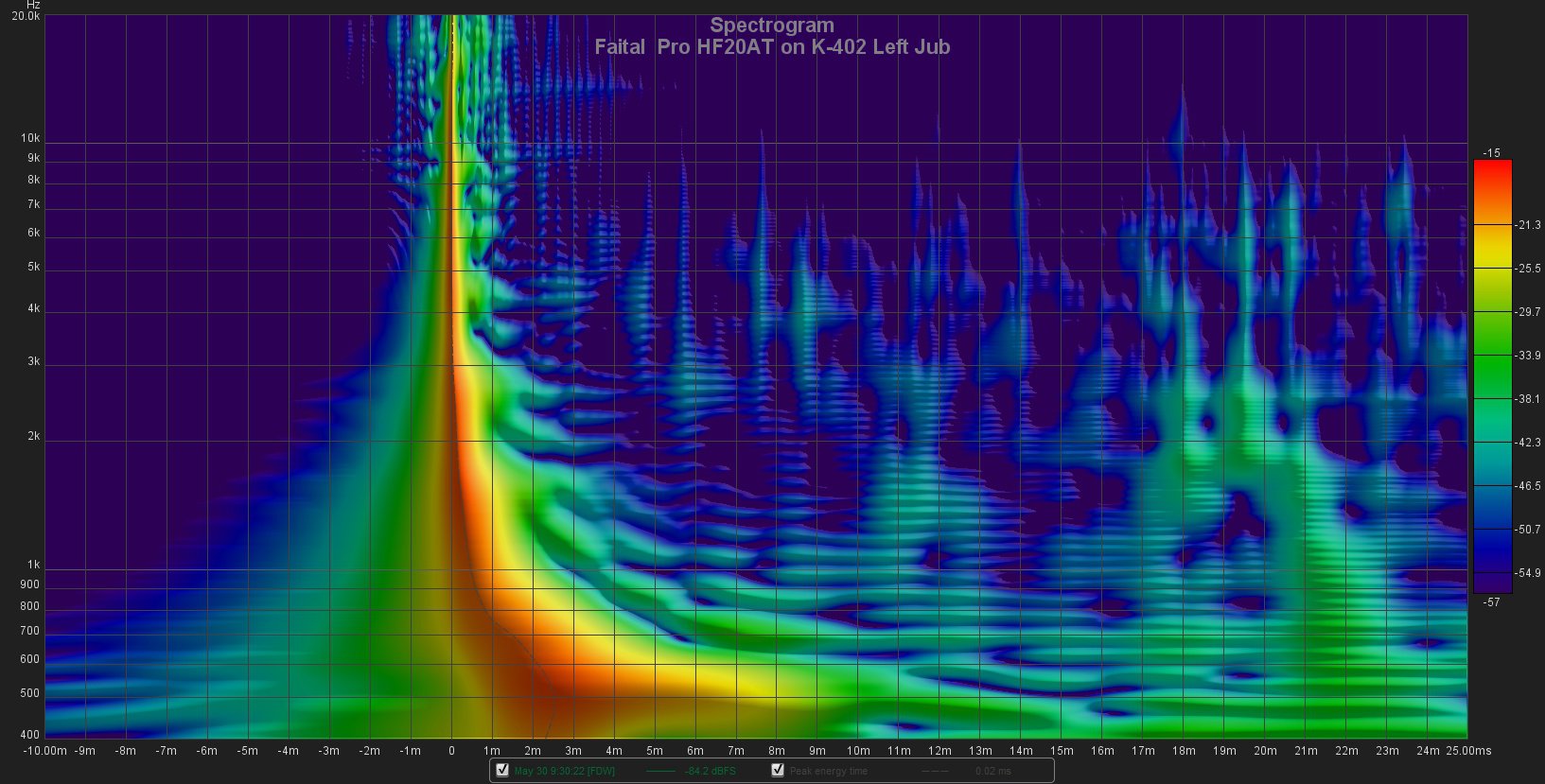
Chris

Chris
hello Cask05,
Would you be so kind as to post SPL curves of both drivers with a 5dB/div. resolution? All these effects should be visible in SPL plots with a reasonable resolution.
The fashion amongst many here is -now the REW or other feeware is widely used- that if any Waterfall/Spectogramme pictures reveal breakup or other resonances, this then is -clearly?-- also audible. "Complete loss of definition of cymbal transients" is quite a strong statement.
I am not so sure myself and would like to know whether there is any validated test/study to confirm this. Furthermore: to what extent does the horn contribute to all this?
Would you be so kind as to post SPL curves of both drivers with a 5dB/div. resolution? All these effects should be visible in SPL plots with a reasonable resolution.
The fashion amongst many here is -now the REW or other feeware is widely used- that if any Waterfall/Spectogramme pictures reveal breakup or other resonances, this then is -clearly?-- also audible. "Complete loss of definition of cymbal transients" is quite a strong statement.
I am not so sure myself and would like to know whether there is any validated test/study to confirm this. Furthermore: to what extent does the horn contribute to all this?
Sure (enclosed below)...hello Cask05, Would you be so kind as to post SPL curves of both drivers with a 5dB/div. resolution? All these effects should be visible in SPL plots with a reasonable resolution.
The fashion amongst many here is -now the REW or other feeware is widely used- that if any Waterfall/Spectogramme pictures reveal breakup or other resonances, this then is -clearly?-- also audible. "Complete loss of definition of cymbal transients" is quite a strong statement.
I'm not sure which denigrating comment to address next, i.e., the use of REW "feeware" and its "Waterfall/Spectrogramme pictures", the correlation of what I've heard over the last few years to the impulse spectrogram plots that I posted, or the audacity to say it on such a distinguished publication as the peer reviewed diyAudio? Which should I choose first?
Honestly, I think that you should check the URL again. You may notice that this is an amateur forum of DIY audio enthusiasts. Also, in the geographical locale where I reside, it is actually considered very unfriendly to talk in such a manner. (It may not be so where you reside, however.) I find that friendly statements of simple disagreement suffice without reference to "appeal to authority" embedded.
As far as describing the effect of cymbal transients using said K-691 driver on K-402 horn, I'll not play apologetics. The correlation sequence in this case was: first that I heard this chattering--over the period of 10 years or so with like 2" compression drivers from B&C and other manufacturers--then I found that the impulse spectrogram plots consistently showed the time-domain behavior quite clearly, but SPL plots ("Bode plots") did not.
I believe that is the question of this thread, and if the OP had his answer beforehand from a "validated test/study to confirm this", I don't believe that he would have asked the question to begin with--he would have likely consulted his peer reviewed technical sources.
As far as the horn effects, I believe that you'll have your answer by looking at the TAD TD-4002 spectrogram, which is why I posted that particular plot. The TAD TD-4002 has a beryllium diaphragm, and is the driver that I've used on the K-402 horns on my two-way Klipsch Jubilees for over 10 years now. I believe that you will see that the mouth bounce effects are quite benign after 1 ms--corresponding mostly to the horn's contributions to the time behavior. The dimensions of the mouth of the Klipsch K-402 horn is approximately one metre (width) by a half meter (height), with no slots or other throat artifacts to increase the presence of higher order modes. I've heard no other horns with performance approaching this horn's performance. It is the reference by which I judge all other 2" throat horns.
Chris
Attachments
Last edited:
Being a bit aside of the topic... I feel really sorry for this but actually I built my loudspeaker system around those crappy metal drivers with their inherently bad behaviour. Both woofer and tweeter are plagued with wild cone break-ups occuring at 4,5 kHz and 27 kHz. The peaks are very severe, reaching nearly +15 dB over main SPL axis. Just looking at these nasty graphs in REW causes blood pouring from my ears. Everytime when I'm measuring their raw response I am concerned if my mic is not damaged after measurements. And that bad 3-rd order distortion products occuring here and there... Just completely impossible to listen to it. What is more, Qms of my woofers is only 2.14 so they probably sound very dull. Nightmare!
In fact, this system is one of the most accourate and complete sounding systems in the world.
Please consider other factors of loudspeaker drivers mechanics and their proper implementations rather than only looking at their raw responses.

In fact, this system is one of the most accourate and complete sounding systems in the world.
Please consider other factors of loudspeaker drivers mechanics and their proper implementations rather than only looking at their raw responses.

Last edited:
Joachim Gerhard and Troels Gravesen both like low mechanical loss, ie high Qms. This might come with more breakup, needing more crossover work, but is a more revealing and dynamic speaker. Well, there is something in it. The overly well-behaved and inefficient driver can tend to dullness. IMO.
Was perusing this thread just now and I thought I would point out that your mention of Qms and low damping doesn't really have anything at all to do with the breakup region, which is what is being discussed here. Qms is only a characteristic of the resonance region (low frequency) damping. It has nothing to do with internal damping within the cone itself, e.g. damping of the standing wave resonances that are what gives rise to "cone breakup" at the upper end of the driver passband. I'm not sure if anyone else bought this up in a subsequent post, but it's an important point.
You other points in that post were pretty much spot on, however.
Being a bit aside of the topic... I feel really sorry for this but actually I built my loudspeaker system around those crappy metal drivers with their inherently bad behaviour. Both woofer and tweeter are plagued with wild cone break-ups occuring at 4,5 kHz and 27 kHz. The peaks are very severe, reaching nearly +15 dB over main SPL axis. Just looking at these nasty graphs in REW causes blood pouring from my ears. Everytime when I'm measuring their raw response I am concerned if my mic is not damaged after measurements. And that bad 3-rd order distortion products occuring here and there... Just completely impossible to listen to it. What is more, Qms of my woofers is only 2.14 so they probably sound very dull. Nightmare!
In fact, this system is one of the most accourate and complete sounding systems in the world.
Please consider other factors of loudspeaker drivers mechanics and their proper implementations rather than only looking at their raw responses.

I'm happy for you that you feel your system is "one of the most accurate and complete sounding systems in THE WORLD" (emphasis my own) 😱. However, resonances like those tall ones you find from e.g. Seas L series drivers ARE problematic and here's why: Let's say you cross over low to AVOID the resonance. OK, that's a good effort. There will be little electrical energy input at the breakup frequency. I hope that the attenuation is already MUCH more (e.g. 12dB or more) than the height of the resonance peak at the resonance frequency. But the electrical input is not the only source of acoustic energy. The tweeter is probably right next to the bell-like alu cone, and it's not a bad source of energy input at e.g. 5kHz-7kHz. Remember, breakup is a mechanical resonance and acoustic energy input (from internal or external sources) can excite it.
Also, as pointed out by TMM in his earlier post in this thread, some IMD will be LOWER in frequency than the breakup peak. These will be appearing in the low kHz region where the ear is pretty sensitive. There is no way to eliminate this distortion via the crossover or other means.
IMHO tall resonance peaks really rule out some hard cone drivers for these reasons.
In more recent metal cone driver, manufacturers seem to have made a lot of progress towards reducing the magnitude of the breakup region resonances, and I would strongly prefer these drivers over earlier ones.
Last edited:
- Status
- Not open for further replies.
- Home
- Loudspeakers
- Multi-Way
- Cone break-up - how to quantify with measurements?
